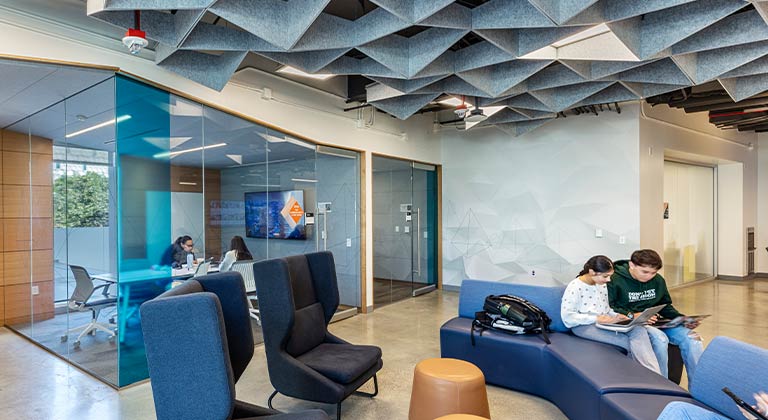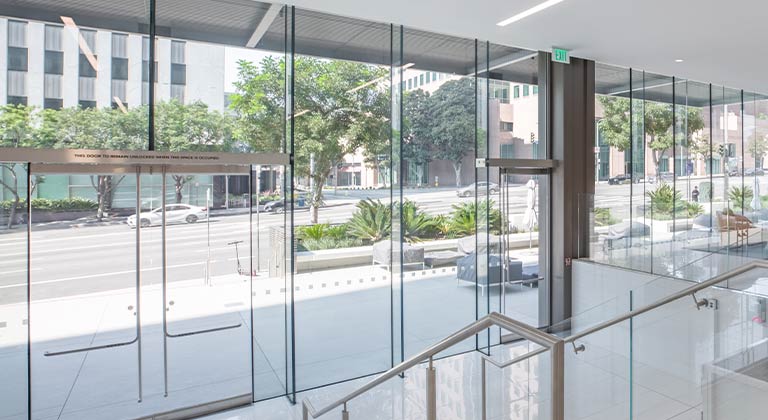
The materials you choose for your building’s exterior will affect how much noise enters your building from the outside. Similarly, the materials you install inside your building will affect the transmission of interior sounds as well. Since builders commonly use significant amounts of glass in both building envelopes and interiors, understanding and choosing the right types of glass and appropriate Sound Transmission Class (STC) ratings can help to reduce sound transmission.
A glass type’s STC rating measures how effectively glass will provide sound insulation. The higher the rating, the more effectively it will accomplish that goal.

How STC Ratings are Determined
The STC rating measures sound resistance through a material, on a scale from 0 to 100. A rating of 0 on glass means that all sounds will be transmitted, no sound insulation at all is provided. A rating of 100 means that all sounds are effectively muted, and no sound will be transmitted.
STC ratings are calculated by measuring the sound level in decibels (dB) on one side of a material and then measuring the sound level on the other. The STC rating is the difference in dB between the two measurements.
The typical range of STC ratings for:
- a single-pane of glass is 20 to 25;
- double-glazed glass is about 28 to 33;
- laminated and double-glazed combinations is about 40.
To effectively “soundproof” a space requires utilizing glass and window systems with an STC rating of 45 to 50 or higher.
Examples of STC Ratings Effectiveness
How do these ratings relate to real-life experience? Picture being inside an office with a glass wall, and other people are talking in the hallway just outside.
- If you can clearly hear them talking, expect your glass wall to have an STC rating of about 25.
- If you hear a conversation, but can no longer understand what’s being said, expect an STC rating of about 30-35.
- The sound of their intense shouting will be reduced at a rating of about 40-45.
- You’ll hear nothing at a rating of 55.
When is a High STC Rating Essential?
A high STC rating is essential in situations where noise reduction is a priority. For example, in buildings located near busy roads, airports, fire stations, or in urban areas with high levels of exterior noise, it is important to minimize the amount of sound that enters the building. Similarly, in environments that require privacy or quiet working spaces, such as offices, conference rooms, or hospitals, a high STC rating can reduce the transmission of interior sounds and ensure confidential conversations.
Understanding the STC rating for different types of glass is an essential component of your project. It will help you understand when to use a specific type of glass to obtain the rating you require.
For instance, a single pane of glass with a rating of 25 is best utilized for a building located in a quiet area with minimal outside noise. Ideally, office spaces should install windows with an STC rating of 35 and higher to block most urban noise from entering the building.
If your building requires complete soundproofing — a recording studio, for example — you’ll have to consider the combination of STC rating in the building envelope, windows and wall insulation to achieve the desired overall rating. A rating of 45 or higher is considered almost “soundproof.”
The type of windows you choose plays a factor in the overall STC rating, and there are several options to consider:
Single-Pane Glass: Single-pane windows provide little protection against outside noise, due to low STC ratings of 20-25. Laminated glass panes can increase their STC rating if the budget allows.
Double-Glazed and Insulating Glass Units (IGUs): Double- or triple-glazing windows with airspace between the glass layers, filled with air or inert gas for extra insulation, will reduce sound transmission. Features such as glass thickness, the distance between panes, gas filling, and spacer material will affect the STC rating. IGUs include laminated glass and airspace to improve both thermal and acoustic performance.
Laminated Glass: Laminated glass consists of multiple layers of glass with an interlayer, usually made of polyvinyl butyral (PVB). Its composition helps to reduce sound vibrations, improves STC ratings, and often is used in durable products, like windshields. Laminated glass can have STC ratings of 40 or more.
Laminated and Double-Glaze Glass Combinations: Combining laminated and double-glazed glass is best for ideal soundproofing. Both achieve an STC rating of 40, but higher ratings require a combination.

Factors That Affect Your Glass STC Rating
Beyond the type of windows you select, other factors can affect the STC rating of your glass.
It’s important also to consider:
- Glass thickness: thicker glass typically provides better sound insulation than does thinner glass. The mass and density of the glass contribute to reducing sound transmission
- Seals and frames: the overall STC rating can be affected by the effectiveness of the windows’ seals and frames. Well-constructed and well-sealed window frames will minimize the transmission of sound around the edges of the glass.
- Specific STC-rated glass products: glass manufacturers produce glass products with the specific goal of providing high STC ratings. These specialty products may include advanced technologies, such as acoustic layers or coatings to enhance sound insulation properties.
The Perfect STC Rating for Your Project
STC ratings are an important number to keep in mind when planning your project. When choosing the right glass for noise reduction, it’s important to consider the unique requirements for the business needs of your building, as well as its surrounding environment. Consulting with knowledgeable glass professionals can guide you in choosing the right type of glass — with the appropriate STC rating — to achieve the desired level of sound insulation for your building, both inside and out.
Contact us for more information about STC ratings and how we can help your project achieve the rating that’s best for your building.
